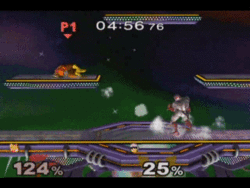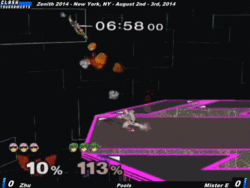Moonwalk: Difference between revisions
(→Charlie walk: Added source video and reference to Fuzzyness) |
m (→Charlie walk: Adjusted wording) |
||
| Line 21: | Line 21: | ||
=== Charlie walk === | === Charlie walk === | ||
[[File:Charlie walking Melee.gif|thumb|250px|Smasher {{Sm|Zhu}} Charlie walking in ''Melee'' during a tournament match.]] | [[File:Charlie walking Melee.gif|thumb|250px|Smasher {{Sm|Zhu}} Charlie walking in ''Melee'' during a tournament match.]] | ||
The Charlie walk, discovered by {{Sm|Fuzzyness}} | The Charlie walk, discovered in 2006 by {{Sm|Fuzzyness}} (whose real name is Charles), is an extension of the sticky walk. The technique is executed by performing a sticky walk and then initiating the turnaround (called "TURNRUN" in the animation debug overlay) animation by moving the control stick in the direction opposite the character is facing. | ||
If one wants to string multiple Charlie walks into each other, the player must reverse the direction of the control stick on the frame that the turnaround animation ends. This initiates a dash, which one then must use to begin another moonwalk to repeat the entire process. If the player were to reverse the control stick earlier, the turnaround animation would end in a pivot. If the player were to reverse the control stick any later, the turnaround animation would end in a run and then another turnaround in the opposite direction. | If one wants to string multiple Charlie walks into each other, the player must reverse the direction of the control stick on the frame that the turnaround animation ends. This initiates a dash, which one then must use to begin another moonwalk to repeat the entire process. If the player were to reverse the control stick earlier, the turnaround animation would end in a pivot. If the player were to reverse the control stick any later, the turnaround animation would end in a run and then another turnaround in the opposite direction. | ||
Revision as of 04:57, April 17, 2015

In Super Smash Bros. Melee, the moonwalk is a technique that involves sliding backwards during in the initial dash animation. Discovered by the smasher Mr.C, the technique is named after the signature dance move of famed pop singer Michael Jackson.
Performing the moonwalk
Moonwalking is achieved by tilting the control stick backwards while dashing, but without passing through the neutral position. The only easy way to do this is to rotate the stick below the neutral position (as going above results in a jump), but just barely below as to prevent losing some distance from crouching; as a result, the player needs to turn the stick so that it forms a semielliptical shape instead of a semicircular shape. This should result in the user doing a backwards slide, but in a state more similar to dashing than to wavedashing.
Alternatively, it's possible to moonwalk by very quickly smashing the control stick backwards after the first frame of a dash, fast enough that the game doesn't detect the stick in the neutral position. This variation yields slightly longer moonwalks and is thus considered a perfect moonwalk, but the sub-frame precision required is exceptionally difficult, and so outside of TAS scenarios it is never seen in practice.
All characters in the game can moonwalk, though some might require the use of the Bunny Hood before a noticeable effect can be seen. A majority of characters, however, require an extra step; they need to start from a walk (specifically not a run) in the direction opposite the way the character faces during the slide.
Variations of the moonwalk
There are two documented variations of the moonwalk: the sticky walk and the Charlie walk.
Sticky walk
The sticky walk is an extension of the moonwalk. The process is outlined below.
First the player must execute a normal moonwalk by dashing one direction and then rolling the stick underneath neutral to the direction opposite of the original direction. Then, before the initial dash animation ends, the player must roll the stick underneath neutral back to the original direction. This initiates the standard running animation of the character. If the sticky walk was performed well enough, the character will continue sliding backward temporarily, slow to a stop, and then begin to run forward. However, because the speed of the animation is directly proportional to the speed of the character's movement across the stage, the character's running animation slows to a stop at the apex of the sticky walk and then resumes in slow motion.
Charlie walk

The Charlie walk, discovered in 2006 by Fuzzyness (whose real name is Charles), is an extension of the sticky walk. The technique is executed by performing a sticky walk and then initiating the turnaround (called "TURNRUN" in the animation debug overlay) animation by moving the control stick in the direction opposite the character is facing.
If one wants to string multiple Charlie walks into each other, the player must reverse the direction of the control stick on the frame that the turnaround animation ends. This initiates a dash, which one then must use to begin another moonwalk to repeat the entire process. If the player were to reverse the control stick earlier, the turnaround animation would end in a pivot. If the player were to reverse the control stick any later, the turnaround animation would end in a run and then another turnaround in the opposite direction.
Because the Charlie walk adds horizontal speed during the turnaround animation, execution of successive Charlie walks produces more backwards momentum faster compared to a string of perfect moonwalks, thus enabling players to utilize this technique even for characters whose regular moonwalks are considered nonviable.
The Charlie walk is often used as a flashy show-off move, considered technical by top players. It was featured in the first gameplay clip of Perfect Dark, a Fox combo video considered to be an exhibition of the most technical gameplay humanly possible.
Other examples of the Charlie walk:
Use in competitive play
The moonwalk acts as a generally situational technique in the competitive metagame, owing to the greater prevalence of wavedashing. In most cases, the moonwalk is primarily used for extra flash by the smasher.
Moonwalking, however, is not a completely useless technique. The technique can be used in mindgames in order to mix up movement or otherwise bait opponents, adding a degree of unpredictability to a smasher's playstyle. Cautious smashers can also attempt to use the moonwalk as to more efficiently edgehog instead of using a wavedash. In addition, by principle, the moonwalk allows characters to slide backwards while the game recognizes them as standing; as such, smashers can perform techniques similar to wavesmashing and wavegrabbing with the technique, provided their character has a sufficiently long moonwalk.
Due to his powerful edgeguarding game and long moonwalk, Captain Falcon derives the most applications from moonwalking, as the backward momentum from moonwalking can allow him to slide off the stage in order to intercept recovering opponents with an aerial attack. In some cases, this can actually act as a superior alternative to going offstage with other techniques, as the moonwalk can move Captain Falcon much farther offstage and will also allow Falcon to retain his double jump, allowing for safer recovery.
Moonwalking distance
The moonwalk is most noticeable when used by Captain Falcon, though some other characters, like Link and Mewtwo, also have rather noticeable moonwalks. The following characters can moonwalk without needing to walk in the opposite direction, ranked by distance:
Assuming the extra step is added and the character is wearing a Bunny Hood, the distances can be listed via the following list:
- Captain Falcon
- Mewtwo
- Young Link
- Link
- Yoshi
- Ganondorf
- Bowser
- Peach
- Sheik
- Kirby
- Samus
- Luigi
- Donkey Kong
- Zelda
- Falco
- Fox
- Pichu
- Pikachu
- Roy
- Dr. Mario
- Mario
- Jigglypuff
- Ness
- Marth
- Ice Climbers
- Mr. Game & Watch